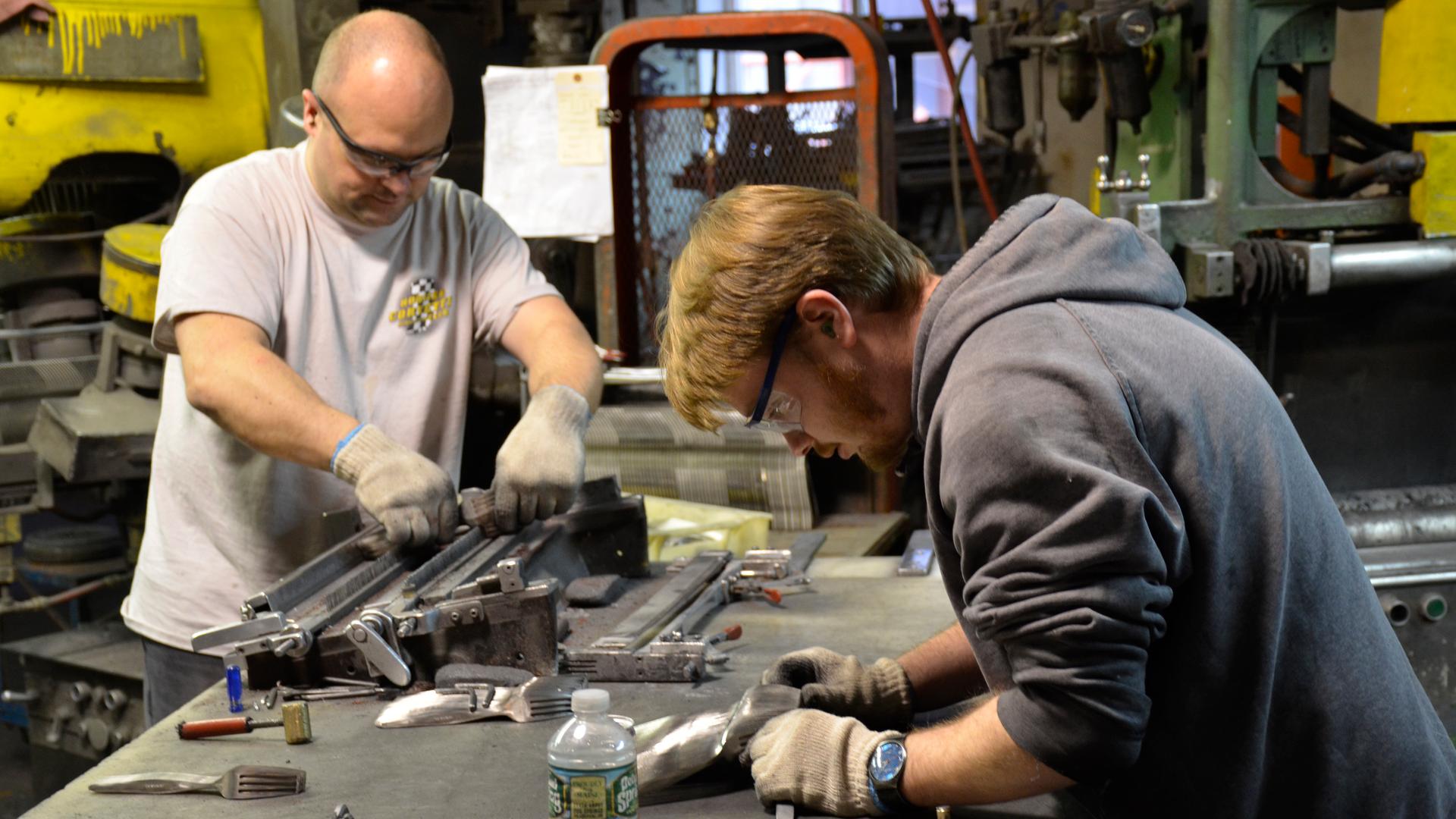Oneida Limited had been making flatware in Sherrill, New York, since 1880, but the factory was shut down in 2005 and work was shifted to Asia. Today, 53 people are working at a new company, Liberty Tabletop, which promotes itself as the only flateware manufacturer in the US.
President Donald Trump once named his style of elocution “truthful hyperbole” — what he described as a form of promotion to get people excited. One area the president currently likes to pump up is foreign jobs coming back to the United States.
“We have literally hundreds of companies moving back,” President Trump said in November, repeating a statement that’s become a major talking point.
But is this another instance of truthful hyperbole? Are hundreds of companies indeed shifting production back to the US?
“I’d say 300, 400, at least, announced in 2017,” said Harry Moser, president of the Reshoring Initiative, a nonprofit that tracks jobs coming back to the US.
OK, score one for the president.
But is a few hundred companies significant?
“I would call this movement right now a trickle,” said Scott Paul, president of the Alliance for American Manufacturing.
There’s considerable debate over how to measure any reshoring trends and very little data available. It’s often not as simple as a company closing a factory in China and reopening it in Ohio. Moser, for example, includes “partial shifts” of jobs, whereas some other research only includes shifts of entire businesses, and thus, have reached less optimistic conclusions about reshoring trends.
What is clear, however, said Paul, is that the US is seeing more companies that rely on cheap energy — now in abundance in the US — coming back.
“That includes some types of chemical processing, some types of plastics,” said Paul. “I’ve also seen jobs come back in everything from auto parts to textiles in jeans.”
Paul said this trend began about a decade ago. Moser, who also assists companies with information about the benefits of shifting work to the US, said President Barack Obama got the ball rolling.
“He [President Obama] used to call it ‘insourcing,’” said Moser. “He started a program of increasing our skilled workforce of apprenticeship programs and certificates. He did many useful things.”
According to Moser’s research, things have picked up under Trump, with work largely shifting away mostly from China and other parts of Asia. “In 2017, companies announced 170,000 manufacturing jobs coming back from offshore, up 50 percent from 2016.” (This includes both reshoring and foreign direct investment jobs.)
So, what’s driving this? Let’s look at the case of one manufacturer that moved back.
Oneida Limited began making knives, forks and spoons in Sherrill, New York, back in 1880. It grew into the largest flatware maker in the world. But by the early 21st century, the writing was on the wall — the factory closed down and production was shifted mostly to China, as well as Vietnam and Indonesia.
“And really that decision came down to a very daunting statistic, and that was that they could buy product — finished, packaged and put in a box — shipped all the way from China to Long Beach, California, cheaper than they could buy the raw material to make it with here in Sherrill,” said former Oneida employee Greg Owens.
Owens, however, didn’t accept this. So, he and a partner bought the Sherrill factory.
“Here was a factory that was a little over a million square feet with millions of dollars of equipment. It was the most automated flatware factory in the world by far, and nobody wanted it. So, we were basically offered to purchase it for scrap value,” said Owens.

Thirteen years later, 53 people are working at the Sherrill factory. It’s a far cry from the 2,000 people who made forks and knives here just 20 years ago. But it’s something. So, what made Owens believe that making cutlery in New York was again possible?
“There was actually a study done, I believe it was Consumer Reports, where they did a survey, and 10 percent of the people are pretty adamant about ‘Made in America,’” said Owens. “Eighty percent of the people, if all things are equal, will pay the same or up to 10 percent more for Made in America. When I heard that I went, ‘Hmmm, OK.’”
But how do you compete with wages in Asia that are a fraction of what people make in upstate New York?
“There’s a tremendous markup in the retail chain from a factory in, let’s say China, to the end user in Macy’s,” said Owens. “And what it works out, at the end of the day being, is something that you buy in the store for $100; the Chinese factory is getting $10 for that.”
So, Owens cut out all the middlemen and now sells his flatware directly to customers through the web. He’s now the CEO and co-founder of Liberty Tabletop, branded as the only manufactuer of flatware made in the United States.
It’s a small success story. But not isolated — US manufacturing jobs have slowly been ticking upward since 2009. But so are imports of foreign-made goods: The US now imports more goods from China than ever before.
And how much of Liberty Tabletop’s reshoring story was influenced by Congress or the White House?
“It was not because of anything that was political down in Washington,” Owens said.
Similar question for Moser with the Reshoring Imitative: What’s driving companies back to the US?
“Something everybody can agree on, Chinese wages and prices have gone up significantly in the last 10, 15 years,” said Moser.
Moser also cited increased tax duties, freight expenses and the costs of intellectual property risk and travel as factors that make reshoring more attractive.
Then there’s e-commerce. With many Americans now expecting packages delivered within 24 or 48 hours after they order online, distribution centers need to be replenished quickly, which means, for some products, the source material needs to be closer to the customer. “And all of a sudden, maybe 25 percent of what has been offshored makes sense to come back,” said Moser.
Automation can also even the playing field between the US and China as robotics make American factories increasingly competitive, but also less reliant on manufacturing workers.
For the most part, however, the factors driving manufacturing back to the US are largely beyond a president or Congress’ control. So, how much credit, or blame, does Washington deserve for jobs reshoring back or not reshoring back?
“In the case of President Trump, clearly his tax reductions and regulatory reductions were important. His commitment to US manufacturing gives confidence, especially to the small-to-medium-sized companies, they believe that Washington is on their side now. And they invest more, they hire more, they take more risks than they might’ve otherwise,” said Moser.
But Moser also said some of the president’s other policies could undo much of that: “I think continued steel and aluminum tariffs could be a problem.”
Tariffs were designed, in part, to drive some American manufacturing away from China, although most likely, tariffs work won’t shift work to the US, but to other low-cost Asian nations.
American companies are also taking the long view. “They realize that in five or 10 years, you could have a different president, a different set of policies here,” said Paul. “So, they’re all going to be quite careful about the way in which they approach these decisions.”
And then there’s perhaps the biggest impediment to significant manufacturing growth in the US: American manufacturers need more skilled workers to do the actual work.
Our coverage reaches millions each week, but only a small fraction of listeners contribute to sustain our program. We still need 224 more people to donate $100 or $10/monthly to unlock our $67,000 match. Will you help us get there today?
